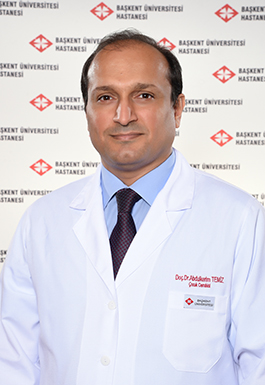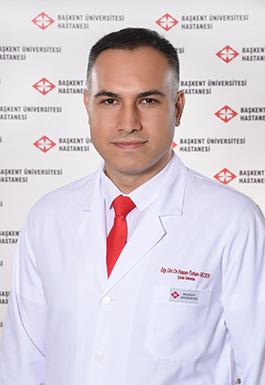Our clinic provides surgical treatments for congenital or acquired diseases observed from the newborn period to adolescence (ages 0-18) involving the neck region, chest wall, lungs, esophagus, stomach and intestinal system, liver and bile ducts, spleen, pancreas, urinary tract, and reproductive organs.
Our clinic consists of a 25-bed pediatric surgery department and an 8-bed neonatal surgery intensive care unit (including 3 enclosed incubators and 5 open beds). The 10-bed pediatric intensive care unit is shared with the department of pediatrics. In our intensive care units, the latest technological devices and instruments are used for the monitoring and treatment of patients. There is a playroom where sick children can play games accompanied by a "child development specialist".
Surgeries in our operating room continue five days a week and half a day on Saturdays. Operations are performed with a specialized anesthesia team experienced in pediatric patient anesthesia, including the newborn period. Emergency interventions and surgeries are performed 24/7.
In our clinic, surgical treatments are applied in line with current medical and technological advancements. Surgeries for diseases such as inguinal hernia, umbilical hernia, undescended testis, hydrocele, and cord cyst, as well as diagnostic endoscopic procedures for the esophagus, stomach, intestinal system, and urinary tract, are performed on an outpatient basis. Patients are discharged on the same day without requiring hospitalization.
Our outpatient clinic services are available five full days a week and half a day on Saturdays. Urodynamics and uroflowmetry devices installed in our hospital are used for patients who require examination and treatment due to urinary tract diseases.
Weekly on Fridays, joint pediatric urology-nephrology councils are held with the department of pediatric nephrology. Based on the council's decisions, diagnostic and treatment plans are made for children with congenital or acquired kidney, urinary tract, bladder, and urinary stone diseases. Surgeries for patients decided upon in the council are performed in our clinic using both endoscopic and open methods. Surgical treatments for various congenital anomalies such as hypospadias, epispadias, bladder exstrophy, cloacal exstrophy, and urethral strictures are also performed.
In our hospital, "pediatric oncology councils" are held on the first and third Fridays of each month, with participation from pediatric surgery, pediatric oncology, pathology, radiology, and other relevant departments. Surgical interventions for chest, abdomen, urinary, and reproductive system tumors discussed in this council are performed in the pediatric surgery clinic. For cancer patients where surgery is not an option, procedures like central catheter – PORT catheter insertion are also carried out in the pediatric surgery clinic for easier chemotherapy administration.
Surgical procedures for life-threatening and complex conditions requiring post-operative intensive care, such as foreign body aspiration in the trachea, pleural infection, and congenital lung diseases (bronchogenic cyst, congenital lobar emphysema, cystic adenomatoid malformation, tumoral masses, etc.), are performed using open or closed methods depending on the patient's condition and disease.
Surgeries for esophageal atresia (undeveloped esophagus), tracheoesophageal fistula (connection between the esophagus and trachea), and congenital or acquired esophageal strictures (strictures due to caustic ingestion, reflux-induced strictures, achalasia, etc.) are performed using both open and closed methods. Gastroesophageal reflux (insufficiency of the stomach valve), obstructions at the exit of the stomach (pyloric stenosis and strictures), and congenital anomalies of the small and large intestines (atresia, malrotation, Meckel’s diverticulum, internal herniation, etc.), as well as diseases that develop later (intussusception, appendicitis, volvulus, etc.), are treated with open or closed methods in emergency conditions. Liver cyst and tumor surgeries, rare in our country, are easily performed using the latest technological devices. Diagnostic interventions and surgeries for congenital anomalies of the bile ducts (biliary atresia, choledochal cysts, etc.) and stone diseases are performed using the appropriate open or closed method.
Pediatric Surgery: Laparoscopic Surgeries
Laparoscopic or minimally invasive surgery, also known colloquially as closed method surgery, is a special application area in surgery. In open surgery, an incision is required to access the abdominal cavity. In laparoscopic (closed) surgery, operations can be completed through several incisions of 0.5-1 cm.
Cannulas inserted into the abdomen from port sites are called trocars. A camera and many specially developed instruments for these techniques are inserted into the abdomen to complete the surgeries. The abdomen is
inflated with carbon dioxide gas to facilitate visibility, creating space for the operation.
Images from the camera are viewed by surgeons on video monitors. This system allows surgeons to perform many traditional surgeries with much smaller incisions. These methods, in experienced hands, are as safe as open surgery.
Advantages of Laparoscopic Surgery:
- Smaller incisions compared to open surgery
- Lower infection risk than open surgery
- Lower postoperative care costs than open surgery
- Shorter hospital stay after surgery than open surgery
- Patients experience much less pain after surgery
- Faster recovery and return to daily life after surgery
Laparoscopic Surgeries Performed in Pediatric Surgery:
- Inguinal hernia surgery
- Ovarian cyst (ovarian cyst) surgery
- Ovarian torsion (twisted ovary) surgery
- Appendicitis surgery
- Gastrostomy opening
- Gallbladder surgery
- Intestinal knotting surgery
- Diagnostic laparoscopy (diagnosing diseases of abdominal organs by examining them with a camera)
- Closed non-palpable testis surgery (finding and relocating testes remaining in the abdomen)
- Closed gastroesophageal reflux surgery
- Closed kidney surgeries
- Closed spleen surgeries
- Diagnosis and closed surgery of cysts and masses in the abdomen
- Laparoscopy-assisted surgeries for anal atresia and Hirschsprung's disease
Thoracoscopic (closed chest surgeries) Surgeries:
- Closed diaphragmatic hernia surgery
- Closed diaphragmatic eventration (elevation) surgery
- Decortication for empyema (VATS)
- Closed bullectomy for spontaneous pneumothorax
- Thoracoscopic biopsies (closed lung-pleura biopsies)
- Mediastinal cyst and mass surgeries
Diseases Information
1. Surgical diseases of the newborn
2. Digestive system surgical diseases
3. Respiratory system surgical diseases
4. Trauma in children
5. Cancer diseases and surgical treaties in childhood
6. Surgical treatment of hormonal diseases
7. Head and neck surgery in children
8. Surgical diseases of the excretory system and reproductive organs
9. Most commonly encountered disease names
1. Surgical Diseases of the Newborn
- Congenital absence, developmental errors of the esophagus, and its relationship with the trachea
- Congenital absence or obstruction of the stomach, duodenum, small intestine, and large intestine
- Herniation of intestines into the chest cavity and insufficient development of the lungs due to absence of the diaphragm (congenital diaphragmatic hernia)
- Congenital anal stricture or absence (anorectal malformations)
- Surgical treatment of diseases related to prematurity
- Intestines located outside the abdomen due to absence of the abdominal wall (omphalocele and gastroschisis)
2. Digestive System Surgical Diseases
- Esophageal (esophagus) strictures, diseases caused by ingestion of caustic and corrosive substances (corrosive esophagitis)
- Stomach strictures, obstructions, and ulcer disease
- Gastroesophageal reflux disease (GERD) and its complications
- Obstruction of the small intestine, polyp disease, inflammatory bowel diseases
- Appendicitis
- Megacolon (enlarged large intestine) due to congenital nerve development disorder of the intestines (Hirschsprung's disease)
- Constipation, anal fissures, and fistula formation
- Hemorrhoids and their surgery in adolescents
- Inguinal hernia, umbilical hernia
- Liver cysts, abscesses, and tumors
- Congenital absence, cystic enlargement, and stone disease of the bile ducts
- Pancreatic cysts and tumors
- Spleen diseases and spleen removal in blood diseases
3. Respiratory System Surgical Diseases
- Congenital lung diseases, cysts
- Treatment of abscesses and empyemas due to lung infections
- Congenital diseases of the trachea
- Foreign body aspiration into the trachea and bronchoscopic interventions
- Pneumothorax, hemothorax
- Deformities of the chest wall (funnel chest, pigeon chest)
4. Trauma in Children
- Traffic accidents
- Falls, assaults, and similar general body traumas
- Shaken baby syndrome
- Cutting, piercing, abdominal, chest traumas
5. Cancer Diseases and Surgical Treatments in Childhood
- Kidney tumors
- Tumors originating from nerve elements
- Soft tissue tumors, lymph node tumors
- Liver tumors
- Surgical treatment of tumors spreading to the lungs
- Ovarian, testicular (ovarian) tumors
- Tumors of other organs
6. Surgical Treatment of Hormonal Diseases
- Thyroid gland (goiter) diseases
- Pancreas diseases
- Adrenal gland diseases
7. Pediatric Head and Neck Surgery
- Neck masses
- Congenital neck cysts and sinuses
8. Surgical Diseases of the Excretory System and Reproductive Organs
- Kidney cysts, tumors, and stone disease
- Kidney-ureter junction narrowing (UPJ obstruction)
- Ureter-bladder junction narrowing (UVJ obstruction)
- Ureteral dilatation, stones
- Vesicoureteral reflux (VUR) (Backflow of urine from the bladder to the ureter)
- Bladder infections, stone disease
- External opening of the bladder due to the absence of the anterior abdominal wall (Vesica Extrophia)
- Urethra opening on the underside in male children (hypospadias)
- Undescended testis, hydrocele, spermatic cord cyst
- Epididymo-orchitis (testicular inflammation), balanitis-posthitis (inflammation of the foreskin) and prostatitis
- Circumcision
- Ovarian cysts, torsion in female children
- Imperforate hymen, labial adhesions
9. Most Commonly Encountered Diseases
- Inguinal hernia, hydrocele (water hernia), cord cyst
- Umbilical hernia
- Undescended testis
- Acute scrotum (emergency surgeries of the testes and scrotum)
- Umbilical polyp and granuloma
- Rectal bleeding (intussusception, anal fissure, polyp)
- Fecal incontinence
- Urinary incontinence (day and night)
- Appendicitis in children
- Children with hypospadias (prophet's circumcision)
- Pyloric stenosis in infants
- Micro penis
- Circumcision
- Foreign body ingestion and aspiration
Commonly Applied Diagnostic Methods
- Pediatric esophagoscopy-gastroscopy
- Pediatric esophageal dilatation
- Pediatric bronchoscopy
- Pediatric rectosigmoidoscopy
- Pediatric cystoscopy
- Pediatric laparoscopy
- Pediatric thoracoscopy
- Pediatric anorectal manometry
- Pediatric esophageal manometry
- Pediatric urodynamics
- Pediatric esophagoscopy-gastroscopy
Esophagogastroscopy is a procedure for examining the esophagus and stomach with a tool called an esophagogastroscope, performed under general anesthesia in children. It is conducted to examine the esophagus, stomach, and if necessary, the duodenum and the beginning of the small intestine, to take samples, remove foreign objects, and apply medication to enlarged veins within the esophagus and stomach.
Pediatric esophageal dilatation
Esophageal dilatation is the procedure of widening strictures in the esophagus using balloons or various bougies, performed in the operating room under general anesthesia in children. Our clinic primarily prefers balloon dilatation.
Pediatric bronchoscopy
Bronchoscopy is the examination of all the respiratory pathways from the larynx onward, using a camera-containing tool called a bronchoscope, in the form of video endoscopy. It is performed under general anesthesia in children. This procedure is used to examine the respiratory pathways, take samples, remove foreign objects, and investigate connections between the respiratory pathways and the esophagus. It requires hospitalization.



